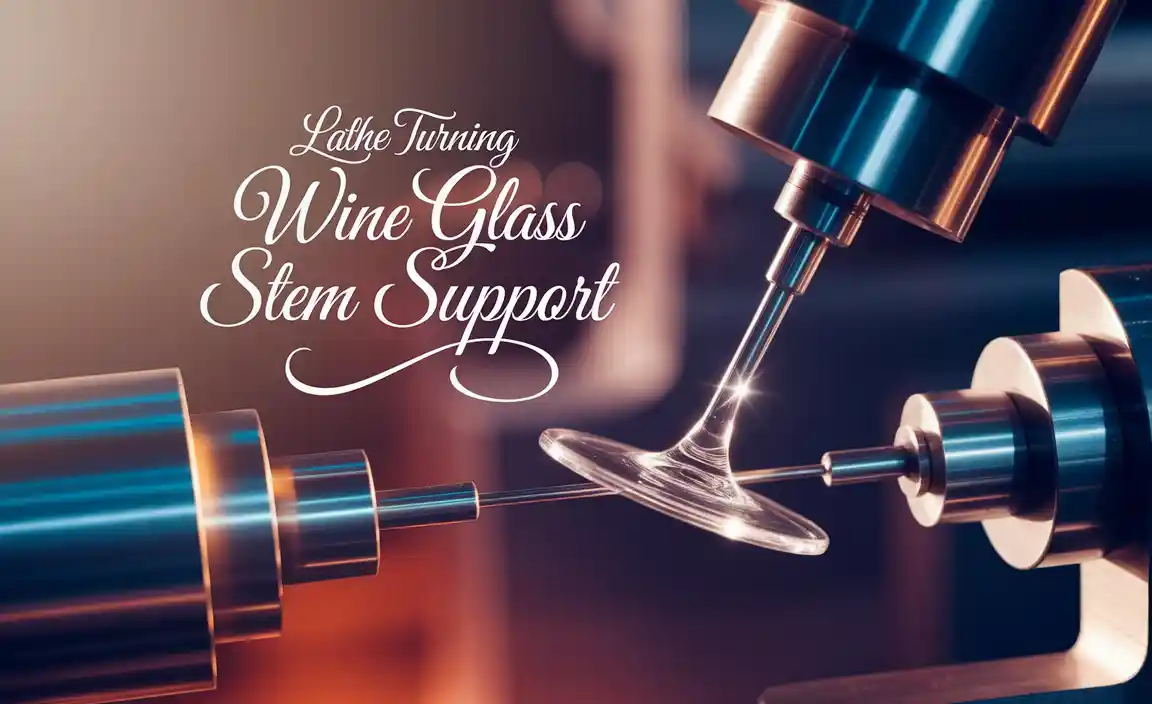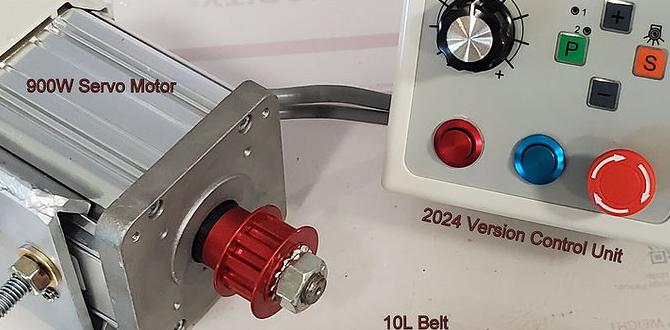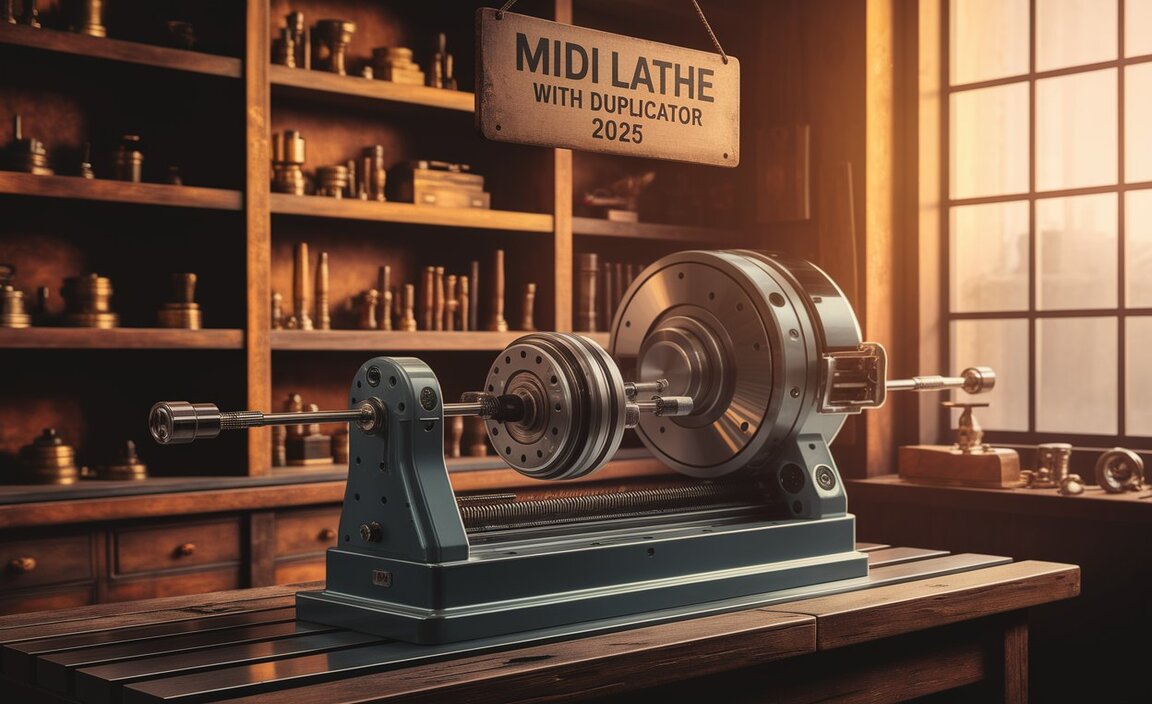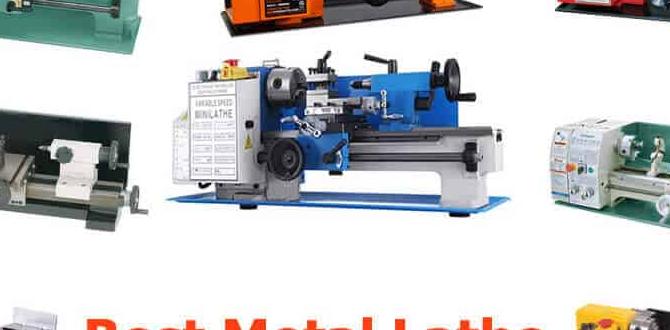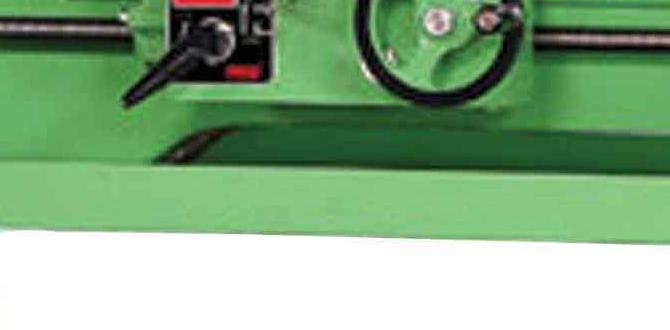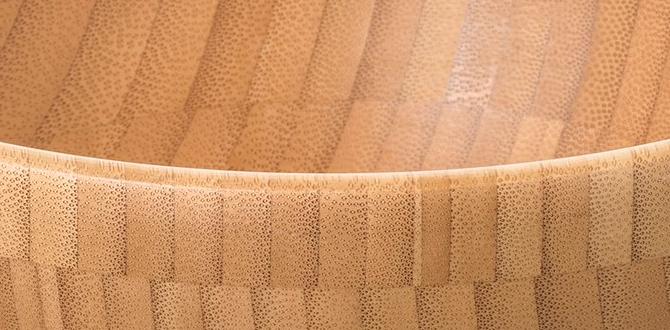A wood lathe with a cast iron bed offers superior stability, durability, and vibration dampening for smoother turning and more precise woodworking. It’s an excellent investment for hobbyists and professionals seeking a reliable foundation for their craft.
Are you dreaming of crafting beautiful bowls, spindles, or intricate decorative items from wood? Perhaps you’ve looked at lathes and felt a bit overwhelmed by the choices. Many beginners get stuck wondering if a particular feature, like the bed material, really makes a difference. You’re not alone! The good news is, it absolutely does, and understanding it can significantly impact your woodworking journey. A sturdy foundation is key to precise work and enjoyable turning. We’re going to walk through exactly why a wood lathe with a cast iron bed is such a smart choice for anyone serious about woodworking. Let’s dive into what makes these machines so fantastic and how to get the most out of yours.
Why a Cast Iron Bed is a Game-Changer for Wood Lathes
When you’re just starting with woodturning, the sheer variety of tools can seem daunting. You see lathes with cast iron beds, steel beds, and even heavy wooden frames. It’s easy to think, “Does it really matter?” Well, yes, it really does, especially when it comes to the bed of the lathe. The bed is the backbone of your machine. It supports the headstock, tailstock, and tool rest, and anything that happens here directly affects the accuracy and finish of your wood projects. Let’s explore why cast iron stands out as the premier material for lathe beds.
Understanding the Role of the Lathe Bed
Think of the lathe bed as the main beam on a house. It needs to be strong, stable, and perfectly straight. Any wobbles, vibrations, or misalignment in the bed will translate directly into your work. If the bed isn’t rigid, the spinning workpiece can vibrate, leading to:
- Rough surfaces on your turned items.
- Difficulty in achieving precise shapes and dimensions.
- Increased wear and tear on the lathe’s components.
- A less enjoyable and potentially dangerous turning experience.
The material and construction of the bed are therefore critical factors in determining the lathe’s performance and your satisfaction with it.
The Superiority of Cast Iron
Cast iron is a metal alloy primarily composed of iron, carbon, and silicon. It’s renowned for its excellent vibration-dampening qualities and rigidity. Here’s why it’s a top choice for lathe beds:
- Vibration Dampening: When you’re turning wood, especially at higher speeds or with unbalanced blanks, vibrations are inevitable. Cast iron is naturally good at absorbing these vibrations. Unlike lighter materials that might transmit them, cast iron effectively “soaks them up,” leading to a much smoother turning process and cleaner cuts.
- Rigidity and Stability: Cast iron is incredibly dense and rigid. This means it doesn’t flex or bend easily under load. A rigid bed ensures that the headstock and tailstock remain perfectly aligned, no matter how much pressure you apply with your tools. This stability is crucial for accuracy.
- Durability and Longevity: Cast iron is tough and resistant to wear. A well-built cast iron lathe bed can last for many decades, making it a sound, long-term investment for any woodworker. It’s less prone to scratches, dents, and warping compared to other materials.
- Weight: The inherent weight of cast iron contributes significantly to its stability. A heavier machine is harder to move, but that extra mass acts as ballast, further reducing vibrations and increasing overall stability.
Comparing Cast Iron to Other Materials
To really appreciate cast iron, it helps to see how it stacks up against other common lathe bed materials:
- Ductile Iron: A variation of cast iron that offers even greater toughness and impact resistance. Many higher-end wood lathes use ductile iron for their beds.
- Steel: Steel beds can be very strong and rigid, but they generally don’t dampen vibrations as effectively as cast iron. They can sometimes transmit more vibration, especially if the lathe isn’t substantial or well-built.
- Aluminum: Lighter and more corrosive-resistant than iron, but significantly less rigid and a poor vibrator damper. Lathes with aluminum beds are typically smaller, benchtop models where extreme precision and heavy-duty work aren’t expected.
- Fabricated Steel (Box Ways): Some very high-end industrial machines use fabricated steel with precisely machined box ways. These are extremely rigid but often not found in typical wood lathes due to cost and complexity.
For the vast majority of woodworkers, especially those looking for a serious, dependable machine, a cast iron bed is the sweet spot for performance, durability, and value.
Key Features of a Wood Lathe with a Cast Iron Bed
So, you’re convinced a cast iron bed is the way to go. What else should you look for in a good wood lathe? A solid cast iron bed is just the beginning. Several other components and features work together to make a lathe a pleasure to use and a reliable tool for your projects. Let’s break down the essential elements that complement that sturdy iron backbone.
1. Motor Power and Speed Control
The motor is the heart of your lathe. Its power determines what size and type of wood you can comfortably turn. More importantly, variable speed control gives you flexibility. Lower speeds are great for roughing out large blanks or when working with figured woods that might chip. Higher speeds are perfect for fine sanding and finishing.
- Horsepower (HP): For most beginners and intermediate woodworkers, a 1 HP to 2 HP motor is sufficient. Larger projects or turning very hard woods might benefit from 2 HP or more.
- Variable Speed: This is a must-have feature for most users. Look for lathes with electronic variable speed (EVS) or a belt-driven system with multiple pulley positions that allow you to change speed ranges.
- RPM Range: A wide RPM range is ideal. For example, 250-3800 RPM offers a lot of versatility. A lower minimum RPM is particularly useful for safety when starting with large or irregularly shaped blanks.
2. Swing and Distance Between Centers
These two measurements define the physical limits of what you can turn on your lathe.
- Swing: This is the nominal diameter of the largest workpiece the lathe can turn. It’s measured as the distance from the top of the bedways to the center of the spindle, then multiplied by two. A larger swing means you can turn bigger bowls and platters.
- Distance Between Centers: This is the maximum length of a workpiece that can fit between the headstock and tailstock centers. It dictates the maximum length of spindles or bowls you can turn.
It’s often said, “Get the biggest lathe you can afford and have space for.” While a cast iron bed is a great foundation, ensure the overall physical size and capacity meet your project goals.
3. Headstock and Tailstock
These are the components that hold your workpiece. Their quality and features are critical.
- Headstock:
- Spindle Taper: Most lathes use a Morse Taper (MT) for the spindle. MT#2 is common for smaller lathes, while MT#3 or MT#4 are found on larger, more robust machines. Tapers allow accessories like live centers, drill chucks, or faceplates to be securely mounted.
- Indexing Pin: An indexing pin (often a 24-point mechanism) allows you to lock the spindle in specific positions, which is essential for fluting, carving decorative patterns, or drilling holes around the circumference of your workpiece.
- Reversible Spindle: Some lathes offer a reversible spindle, which can be useful, though less common than other features.
- Tailstock:
- Quill Travel: The tailstock has a movable quill that extends to support the workpiece. Look for a decent amount of quill travel (e.g., 3-4 inches or more) to accommodate various workpiece lengths.
- Alignment: Ensure the tailstock can be easily and accurately positioned along the bedways and locked securely.
- Spindle Taper: The tailstock spindle also usually has a Morse Taper, allowing it to accept live centers, drill chucks, or spur drives.
4. Tool Rest and Banjo
The tool rest is where you place your turning tools as you shape the wood. The banjo is the part that clamps the tool rest to the bedways and can be moved up, down, forward, and backward.
- Robustness: A sturdy tool rest made of solid steel is preferable. It should be easy to adjust its height and position precisely.
- Banjo Clamp: The banjo should clamp securely to the bed without slipping. Look for well-machined mating surfaces between the banjo and the bedways.
- Variety of Tool Rests: Many lathes allow for different shapes and lengths of tool rests to be fitted, offering further customization.
5. Bed Extension and Outboard Turning
For larger projects, especially bowls, you might need to turn the workpiece “outboard” – meaning the faceplate holding the work extends beyond the headstock. This requires a lathe with sufficient counterweight and often an extension bed or a robust swing-away tailstock.
- Outboard Counterbalance: If you plan on turning large bowls, check if the lathe is designed for outboard turning or if it has sufficient mass and stability to handle the forces involved.
- Extension Bed: Some lathes offer optional extension beds that bolt onto the main bed, increasing the distance between centers.
Understanding Wood Lathe Specifications (Example Table)
To help you compare different lathes, here’s a sample table of common specifications. This is illustrative, and actual specs will vary by model:
| Specification | Entry-Level Model | Mid-Range Model | Professional Model |
|---|---|---|---|
| Bed Material | Cast Iron | Cast Iron (Often Ductile Iron) | Heavy Cast Iron (Ductile Iron) |
| Motor Power | 3/4 HP – 1 HP | 1 HP – 1.5 HP | 2 HP – 3 HP |
| Variable Speed | Yes (Electronic or Pulley) | Yes (Electronic) | Yes (Electronic) |
| RPM Range | 400-3000 RPM | 250-3800 RPM | 100-4000 RPM |
| Swing Over Bed | 10″ – 12″ | 12″ – 16″ | 16″ – 20″+ |
| Distance Between Centers | 16″ – 18″ | 18″ – 40″ | 40″ – 60″+ |
| Headstock Taper | MT#2 | MT#2 or MT#3 | MT#3 or MT#4 |
| Tailstock Taper | MT#2 | MT#2 or MT#3 | MT#3 or MT#4 |
| Indexing | 24-Point | 24-Point or 36-Point | 24-Point, 36-Point, or more |
Essential Accessories for Your Cast Iron Wood Lathe
Once you have your sturdy wood lathe with a cast iron bed ready to go, you’ll need a few key accessories to get started. These aren’t just optional extras; they are fundamental tools that enable you to actually turn wood. Investing in quality accessories will enhance your experience and the results you achieve.
1. Turning Tools (Gouges and Chisels)
These are your primary instruments for shaping the wood. A basic set is essential for beginners.
| Tool | Purpose | Beginner Recommendation |
|---|---|---|
| Spindle Gouge | Creating beads, coves, and general shaping of spindles. | A 1/2″ or 5/8″ spindle gouge is a good starting point. |
| Roughing Gouge | Reducing a square blank to a cylinder. | A 1″ or 1 1/4″ roughing gouge is invaluable. |
| Skew Chisel | Smoothing, shearing cuts, parting tools, and scraping. | A 1/2″ or 5/8″ skew chisel is versatile. |
| Scraper | Finishing internal and external surfaces. | A round nose or flat scraper can be helpful. |
| Parting Tool | Cutting grooves and removing waste. | A narrow parting tool (e.g., 1/8″). |
Tip: Look for tools with comfortable handles. While you can save money on raw materials, good quality turning tools make a significant difference in ease of use and the quality of your cuts.
2. Centers and Drive Adapters
These are what hold your workpiece and transfer power from the headstock.
- Spur Drive Center: This attaches to the headstock spindle. It has sharp teeth that dig into the end of the wood to provide rotational drive. Essential for most spindle turning and for facing bowls.
- Live Center: This attaches to the tailstock quill. It has a bearing that allows it to spin with the workpiece, providing support without friction and preventing the wood from splitting. A “cup” live center is a common and versatile choice.
- Faceplate: A flat metal disc that screws onto the headstock spindle. Workpieces (especially bowls) are screwed or glued to the faceplate for turning.
- Screw Chuck: A threaded adapter that screws into the headstock. A specialized wood screw is inserted into the workpiece, and the workpiece is then screwed onto the chuck for turning.
3. Safety Equipment – Non-Negotiable!
Woodturning can be exciting, but safety must always come first. Here are the absolute essentials:
- Safety Glasses or Face Shield: Wood chips and dust fly off at high speeds. Protect your eyes at all costs. A full face shield offers the best protection. See recommendations from the Occupational Safety and Health Administration (OSHA) on eye and face protection.
- Dust Mask or Respirator: Wood dust is harmful to your lungs. A good quality mask rated for fine dust particles is crucial, especially for prolonged sessions.
- Hearing Protection: Lathes can be noisy, especially at higher speeds. Earplugs or earmuffs will protect your hearing.
- Appropriate Clothing: Avoid loose-fitting clothing, jewelry, or anything that could get caught by the spinning workpiece.
4. Sharpening System
Sharp tools are safe tools and produce the best results. Dull tools require more force, are more likely to catch, and tear the wood.
- Sharpening Stone: Various types exist, including oil stones, water stones, and diamond stones.
- Grinder: A slow-speed grinder with specialized jigs (like a Wolverine Grinding Jig) can make sharpening gouges much faster and more consistent.
- Honing Compound: Used with leather strops to achieve a razor-sharp edge.
Proper sharpening technique is a skill in itself, and there are many excellent resources, including videos and guides from tool manufacturers and woodworking instructors.
5. Lathe Stand and Dust Collection
While not “turning” accessories, these are vital for a comfortable and safe workspace.
- Sturdy Stand: Ensure your lathe is mounted on a stable stand that keeps it at a comfortable working height. Many cast iron lathes come with robust steel stands.
- Dust Collection System: Even with a mask, a good dust collection system (like a shop vac with a fine dust filter or a dedicated dust collector) will dramatically improve air quality and help keep your workshop cleaner.
Getting Started: Your First Woodturning Projects
With your cast iron lathe ready and equipped with essential accessories, it’s time for the fun part: turning! Starting with simple projects will help you build confidence and hone your skills without overwhelming yourself. Focus on mastering basic


